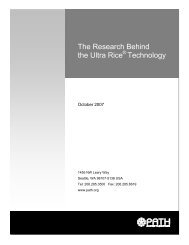Guidelines on stock records for immunization programme - Path
Guidelines on stock records for immunization programme - Path
Guidelines on stock records for immunization programme - Path
You also want an ePaper? Increase the reach of your titles
YUMPU automatically turns print PDFs into web optimized ePapers that Google loves.
5. Processing data<br />
The purpose of a management in<strong>for</strong>mati<strong>on</strong> system (MIS) is to collect, organize and<br />
report data that will be used to make decisi<strong>on</strong>s. In order to define what type of data<br />
should be collected and processed, a detailed analysis of decisi<strong>on</strong>s that will be made<br />
based <strong>on</strong> the in<strong>for</strong>mati<strong>on</strong> generated from these data should be c<strong>on</strong>ducted.<br />
Systems should <strong>on</strong>ly collect in<strong>for</strong>mati<strong>on</strong> that will be used. Collecting in<strong>for</strong>mati<strong>on</strong><br />
that will not be used puts extra burden <strong>on</strong> <strong>programme</strong> staff and makes the in<strong>for</strong>mati<strong>on</strong><br />
flow heavy and slow.<br />
The ultimate measure of an MIS’s success is how the data are used - by whom and<br />
<strong>for</strong> making what decisi<strong>on</strong>s. Recording and processing in<strong>for</strong>mati<strong>on</strong> is not a goal in<br />
itself, but a way to improve decisi<strong>on</strong> making within a supply chain.<br />
5.1 Assessment of <strong>stock</strong> status in a vaccine cold store<br />
In vaccine <strong>stock</strong> management, the main task is to turn numbers into in<strong>for</strong>mati<strong>on</strong> that<br />
can be used to determine whether there is enough <strong>stock</strong> to last until the next planned<br />
arrival.<br />
Time is an essential element in assessing <strong>stock</strong> status. For example, using 1000 doses<br />
of DTP in a week or in a m<strong>on</strong>th are entirely two different situati<strong>on</strong>s. It is highly<br />
recommended that all stores calculate how many m<strong>on</strong>ths supplies will last <strong>on</strong> a regular<br />
basis. This can easily be calculated by dividing the amount of a certain product <strong>on</strong><br />
<strong>stock</strong> by average c<strong>on</strong>sumpti<strong>on</strong> over a period of time. Since data are collected <strong>on</strong> a<br />
m<strong>on</strong>thly basis, the results are submitted as m<strong>on</strong>ths of supply.<br />
M<strong>on</strong>ths of supply =<br />
Quantity in hand<br />
Average m<strong>on</strong>thly c<strong>on</strong>sumpti<strong>on</strong><br />
Quantity <strong>on</strong> <strong>stock</strong> can be found in inventory <strong>stock</strong> card or in store ledger. AMC can<br />
be derived from c<strong>on</strong>sumpti<strong>on</strong> data. As menti<strong>on</strong>ed earlier, issue data substitutes<br />
c<strong>on</strong>sumpti<strong>on</strong> data in vaccine stores. However, this should be used with some cauti<strong>on</strong>.<br />
In an allocati<strong>on</strong>/push system issues data might be less accurate because dispatches<br />
are not based <strong>on</strong> actual c<strong>on</strong>sumpti<strong>on</strong>.<br />
28<br />
Vaccine <strong>stock</strong> management – <str<strong>on</strong>g>Guidelines</str<strong>on</strong>g> <strong>on</strong> <strong>stock</strong> <strong>records</strong> <strong>for</strong> immunizati<strong>on</strong> <strong>programme</strong> and vaccine store managers

















